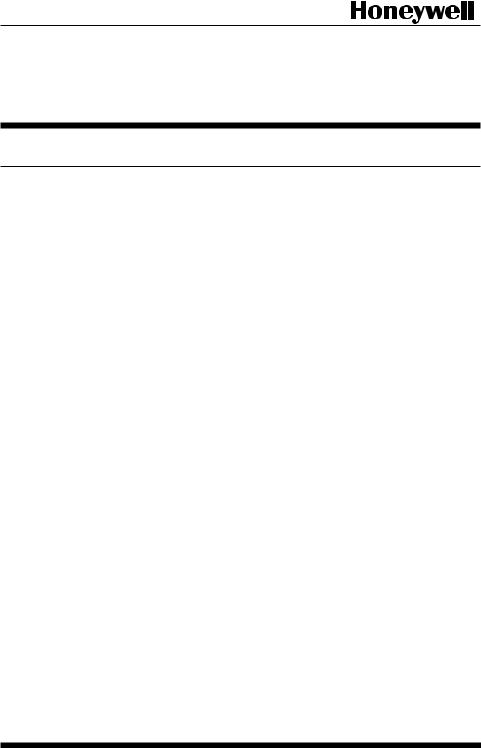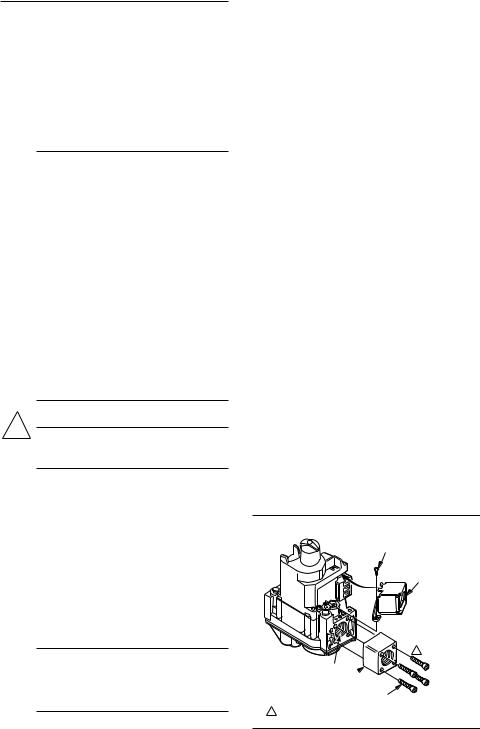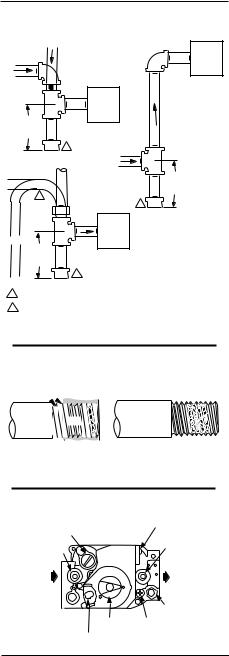Honeywell VR4300A, VR4300C, VR4300H, VR4300M, VR4300P Installation Manual

VR4300
Continuous Pilot
Combination Gas Control
Application
These continuous pilot gas controls are used in gas-fired appliances with capacities up to 300 feet3/hour at one inch wc pressure drop [5.7 meters3/hour at 0.25 kPa] on natural gas. They include a manual valve, safety shutoff, two automatic operators, a pressure regulator, pilot adjustment, and a conduit cover. See Table 1 for temperature ranges and regulator types.
BODY PATTERN: Straight-through body pattern.
INLET X OUTLET SIZES AVAILABLE: 1/2 by 3/4 inch and 3/4 by 3/4 inch.
ADAPTERS: Adapters available for 1/2 and 3/4 inch straight and angle connections. Refer to Table 2.
ELECTRICAL RATINGS:
Voltage and Frequency: 120 Vac, 60 Hz. Current Draw: 0.14A.
Use conversion factors in Table 3 to convert capacities for other gases.
CAPACITY:
Inlet x Outlet |
Capacity at 1 inch wc |
Minimum |
Maximum |
Size (In.) |
Pressure Dropa |
Regulated Capacity |
Regulated Capacity |
1/2 X 1/2 |
180 feet3/hour |
30 feet3/hour |
225 feet3/hour |
|
[5.1 meter3/hour] |
[0.8 meter3/hour] |
[6.4 meter3/hour] |
1/2 X 3/4 |
190 feet3/hour |
30 feet3/hour |
290 feet3/hour |
|
[5.4 meter3/hour] |
[0.8 meter3/hour] |
[8.2 meter3/hour] |
3/4 X 3/4 |
200 feet3/hour |
30 feet3/hour |
300 feet3/hour |
|
[5.7 meter3/hour] |
[0.8 meter3/hour] |
[8.5 meter3/hour] |
aCapacity based on 1000 Btu/feet3, 0.64 specific gravity natural gas at 1 inch wc pressure drop [37.3 MJ/meter3, 0.64 specific gravity natural gas at 0.25 kPa pressure drop].
TABLE 1—TEMPERATURE RANGES AND
REGULATOR TYPES.
|
Ambient |
|
Model |
Temperature |
Regulator |
Number |
Range |
Type |
|
|
|
VR4300A |
0° F to 175° F |
Standard-opening |
|
[-18° C to +79° C] |
|
VR4300C |
0° F to 175° F |
Step-opening |
|
[-18° C to +79° C] |
|
VR4300H |
0° F to 175° F |
Slow-opening |
|
[-18° C to +79° C] |
|
VR4300M |
-40° F to 175° F |
Standard-opening |
|
[-40° C to +79° C] |
|
VR4300P |
-40° F to 175° F |
Step-opening |
|
[-40° C to +79° C] |
|
TABLE 2—ADAPTER (FLANGE) PART NUMBERS.
|
|
Part Number |
|
Inlet/ |
|
Without |
With |
Outlet |
Flange |
Hex |
Hex |
Pipe Size |
Type |
Wrench |
Wrench |
1/2 inch NPT |
Straight |
393690-6 |
393690-16 |
|
Elbow |
393690-3 |
393690-13 |
3/4 inch NPT |
Straight |
393690-4 |
393690-14 |
|
Elbow |
393690-5 |
393690-15 |
NOTE: Flange kits include one flange with attached O-ring and fan mounting screw.
TABLE 3—GAS CAPACITY CONVERSION
FACTORS.
|
Specific |
Multiply Listed |
Gas |
Gravity |
Capacity By |
|
|
|
Manufactured |
0.60 |
0.516 |
Mixed |
0.70 |
0.765 |
Propane |
1.53 |
1.62 |
APPROVALS:
American Gas Association design certificate: UP-70-57A. CanadianGasAssociationdesigncertificate:1029-CC-8375.
T.H. • Rev. 3-93 • © Honeywell Inc. 1993 • Form Number 69-0683—1

Installation
WHEN INSTALLING THIS PRODUCT…
1.Read these instructions carefully. Failure to follow them could damage the product or cause a hazardous condition.
2.Check the ratings given in the instructions and on the product to assure the product is suitable for your application.
3.Assure installer is a trained, experienced service technician.
4.After installation is complete, use these instructions to check out product operation.
 WARNING
WARNING
! FIRE OR EXPLOSION HAZARD CAN CAUSE PROPERTY DAMAGE, SEVERE INJURY, OR DEATH
Follow these warnings exactly:
1. Disconnect power supply before wiring to prevent electrical shock or equipment damage.
2. To avoid dangerous accumulation of fuel gas, turn off gas supply at the appliance service valve before starting installation, and perform Gas Leak Test after completion of installation.
3. Donotbendpilottubingatgascontrolorpilotburner after compression fitting has been tightened because gas leakage at the connection can result.
4. Always install sediment trap in gas supply line to prevent contamination of gas control.
5. Do not force the gas control knob. Use only your hand to push down the reset button or turn the gas control knob. Never use any tools. If the gas control knob or reset button will not operate by hand, replace the gas control using a qualified servicetechnician.Forceorattemptedrepaircan result in fire or explosion.
CAUTION
! Never apply a jumper across or short the valve coil terminals. This may burn out the heat anticipator in the thermostat.
IMPORTANT:
1.These gas controls are shipped with protective seals over inlet and outlet tappings. Do not remove seals until ready to connect piping.
2.When a gas control is installed external to the appliance, a conduit cover MUST be installed. Make sure that conduit cover is placed over the flange before rotating conduit cover into position.
Follow the appliance manufacturer’s instructions if available; otherwise, use the instructions provided below.
CONVERTING BETWEEN NATURAL AND LP GAS
 WARNING
WARNING
! FIRE OR EXPLOSION HAZARD CAN CAUSE PROPERTY DAMAGE, SEVERE INJURY, OR DEATH
Do not use a gas control set for natural gas on LP gas or a gas control set for LP gas on natural gas.
To convert a gas control from natural gas to LP gas or from LP gas to natural gas, contact your Honeywell representative.
Convert standardor slow-opening gas controls from one gas to another with a conversion kit (ordered separately). Order part number 393691 to convert from natural to LP gas. Order part number 394588 to convert from LP to natural gas. Step-opening gas controls cannot be converted.
INSTALL ADAPTERS TO CONTROL
If adapters are to be installed on the gas control, mount them as follows:
Flanges
1.Choose the appropriate flange for your application.
2.Remove seal over gas control inlet or outlet.
3.Assure the O-ring is fitted in the groove of flange. If the O-ring is not attached or is missing, do not use flange.
4.With O-ring facing gas control, align the screw holes on the gas control with the holes in the flange. Insert and tighten the screws provided with the flange. See Fig.
1.Tighten the screws to 25 inch pounds of torque to provide a gas-tight seal.
Bushings
1.Remove seal over gas control inlet or outlet.
2.Apply moderate amount of good quality pipe compound to bushing, leaving two end threads bare. On LP installation, use compound resistant to LP gas. Do not use Teflon tape.
3.Insert bushing in gas control and thread pipe carefully into bushing until tight.
Complete instructions below for piping, installing gas control, connecting pilot tubing, thermocouple and wiring. Make certain the leak test you perform on the control after completing the installation includes leak testing the adapters and screws. If you use a wrench on the valve after flanges are installed, use the wrench on only the flange, not on the control.
USING ADAPTERS TO SOLVE SWING RADIUS PROBLEMS
In some field service applications, it is difficult or impossible to thread the gas control onto the gas supply pipe because of space limitations. This problem can be resolved in many applications by using an adapter. Install the adapter on the end of the supply pipe in place of the gas
Fig. 1—Install flange to gas control.
VALVE OUTLET
FLANGE 
9/64 INCH HEX SCREWS (4)
1DO NOT OVERTIGHTEN SCREWS. TIGHTEN TO 25 INCH POUNDS.
6/32 INCH ROUND SCREWS (1)
CONDUIT
COVER
1
M3098A
2

control by following the same precautions and instructions that are used for installing the gas control. After the adapter is installed, attach the gas control to the adapter as outlined above. Note that using an adapter increases the overall length of the gas control.
LOCATION
Mount the combination gas control in the appliance vestibule on the gas manifold. If this is a replacement application, mount the gas control in the same location as the old control.
Do not locate the gas control where it can be affected by steam cleaning, high humidity, dripping water, corrosive chemicals, dust or grease accumulation, or excessive heat. To assure proper operation, follow these guidelines:
•Locate gas control in a well-ventilated area.
•Mount gas control high enough above the cabinet bottom to avoid exposure to flooding or splashing water.
•Assure the ambient temperature does not exceed the ambient temperature ratings for each component.
•Cover gas control if appliance is cleaned with water, steam, or chemicals or to avoid dust and grease accumulation.
•Avoid locating gas control where exposure to corrosive chemical fumes or dripping water is possible.
Install Piping to Gas Control
All piping must comply with local codes and ordinances or with the National Fuel Gas Code (ANSI Z223.1 NFPA No. 54), whichever applies. Tubing installation must comply with approved standards and practices.
1.Use new, properly reamed pipe free from chips. If tubing is used, assure the ends are square, deburred and clean. All tubing bends must be smooth and without deformation.
2.Run pipe or tubing to the gas control. If tubing is used, obtain a tube-to-pipe coupling to connect the tubing to the gas control.
3.Install sediment trap in the supply line to the gas control. See Fig. 2.
Install Gas Control
1.Mount the gas control 0-90 degrees, in any direction including vertically, from the upright position of the gas control knob.
2.Mount the gas control so gas flow is in the direction of the arrow on the bottom of the gas control.
3.Thread pipe the amount shown in Table 4 for insertion into gas control. Do not thread pipe too far. Valve distortion or malfunction may result if the pipe is inserted too deeply into the gas control. See Fig. 3.
TABLE 4—NPT PIPE THREAD LENGTH IN in.
|
|
Maximum Depth |
|
|
Pipe Can Be |
Pipe |
Thread Pipe |
Inserted Into |
Size |
This Amount |
Control |
3/8 |
9/16 |
3/8 |
1/2 |
3/4 |
1/2 |
3/4 |
13/16 |
3/4 |
|
|
|
4. Apply a moderate amount of good quality pipe compound (do not use Teflon tape) to pipe only, leaving two end threads bare. On LP installations, use compound resistant to LP gas.
5.Remove seals over gas control inlet and outlet if necessary.
6.Connect pipe to gas control inlet and outlet. Use wrench on the square ends of the gas control. If an adapter is used, place wrench on adapter rather than gas control. Refer to Figs. 4 and 5.
Fig. 2—Sediment trap installation.
DROP |
|
|
|
HORIZONTAL |
PIPED |
GAS |
|
GAS |
CONTROL |
||
|
|||
|
SUPPLY |
|
|
|
RISER |
|
GAS |
|
|
CONTROL |
PIPED |
3 INCHES |
|
GAS |
|
SUPPLY |
|
[76] |
|
|
MINIMUM |
|
|
2 |
|
|
DROP |
|
|
HORIZONTAL |
|
3 INCHES |
|
TUBING |
[76] |
1 |
GAS |
MINIMUM |
SUPPLY |
|
|
|
2 |
|
|
|
GAS
CONTROL
RISER
3 INCHES [76] MINIMUM
2
1ALL BENDS IN METALLIC TUBING SHOULD BE SMOOTH.
2CAUTION: SHUT OFF THE MAIN GAS SUPPLY BEFORE REMOVING END CAP TO PREVENT GAS FROM FILLING THE WORK AREA. TEST
FOR GAS LEAKAGE WHEN INSTALLATION IS COMPLETE. |
M3077 |
Fig. 3—Use moderate amount of pipe compound.
TWO IMPERFECT
THREADS  GAS CONTROL
GAS CONTROL
PIPE |
THREAD PIPE THE AMOUNT SHOWN IN TABLE FOR INSERTION INTO GAS CONTROL
APPLY A MODERATE AMOUNT OF PIPE COMPOUND TO PIPE ONLY (LEAVE TWO END THREADS BARE).
M3075
Fig. 4—Top view of gas control.
PRESSURE REGULATOR |
|
WIRING |
ADJUSTMENT |
|
|
(UNDER CAP SCREW) |
|
TERMINALS (3) |
INLET |
|
OUTLET |
PRESSURE TAP |
|
|
|
PRESSURE |
|
|
|
|
|
|
TAP |
INLET |
|
OUTLET |
|
|
PILOT OUTLET |
|
GAS |
PILOT ADJUSTMENT |
|
CONTROL |
(UNDER CAP SCREW) |
RED RESET BUTTON |
KNOB |
M1639C |
3 |
69-0683—1 |
